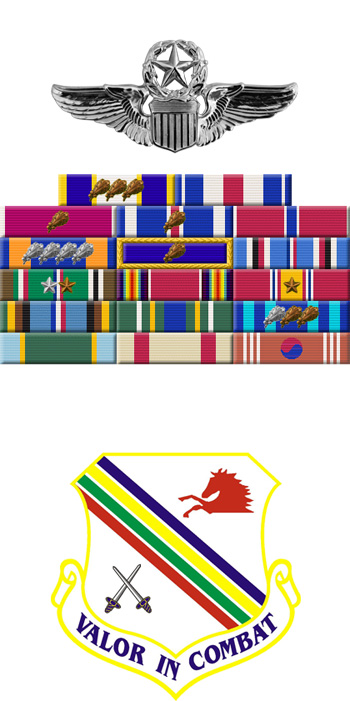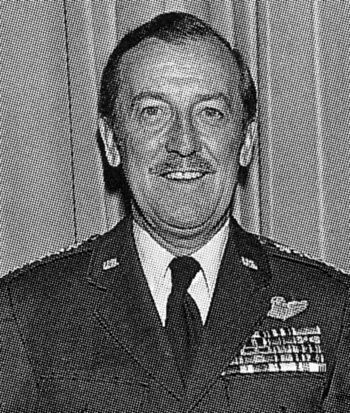
|
Felix Michael Rogers |
 |
|||
| Rank, Service | ||||
General O-10, U.S. Air Force |
||||
| Veteran of: | ||||
|
||||
| Tribute: | ||||
Mike Rogers was born on July 6, 1921, in Sommerville, Massachusetts. He enlisted in the U.S. Army Reserve on April 17, 1942, and entered the Aviation Cadet Program of the U.S. Army Air Forces on August 20, 1942, receiving his commission as a 2d Lt and his pilot wings at Yuma, Arizona, on May 20, 1943. Lt Rogers was first assigned to the 360th Fighter Group, and then transferred to the 353rd Fighter Squadron of the 354th Fighter Group at Hamilton Field, California, flying the P-39 Airacobra, in June 1943, and deployed with the group to England in October 1943. He and his unit transitioned into the P-51 Mustang in November 1943, and he was credited with the destruction of 7 enemy aircraft in aerial combat, 2 damaged in the air, and 5 more destroyed on the ground while strafing enemy airfields, before returning to the U.S. in November 1944. After performing flying duties in the U.S. for most of the last year of the war, Maj Rogers served as commandant of troops at Hunter Field, Georgia, from November 1945 to September 1946, followed by service with the 77th Fighter Squadron of the 20th Fighter Group at Shaw Field, South Carolina, from September 1946 to June 1947. He then received an Air Force Institute of Technology assignment to complete his bachelor's degree at the University of Virginia from June 1947 to August 1949. Col Rogers next served as an intelligence staff officer in the Directorate of Intelligence with Headquarters U.S. Air Force in the Pentagon from August 1949 to October 1952, followed by language school at Lacaze Academy in Washington, D.C., from October 1952 to June 1953. He served as assistant air attache in Madrid, Spain, from June 1953 to February 1957, and then served as chief of the Current Intelligence Branch in the Office of the Deputy Chief of Staff for Operations with Headquarters U.S. Air Force in the Pentagon from February 1957 to July 1958, when he transferred to the Joint Chiefs of Staff as director of current intelligence. Col Rogers served in this position until August 1960, and then attended the National War College in Washington, D.C., from August 1960 to June 1961. His next assignment was as deputy for operations center activities in the Office of the Assistant Secretary of Defense at the State Department from July 1961 to May 1962, followed by service as secretary of the Air Force Council in the Office of the Vice Chief of Staff of the Air Force from May 1962 to February 1963. Gen Rogers next served as director of the secretariat on the Air Force Council Designated Systems Management Group in the Pentagon from February 1963 to August 1966, and then as assistant deputy chief of staff for development plans at Headquarters Air Force Systems Command at Andrews AFB, Maryland, from September 1966 to July 1968. He served as deputy chief of staff of the same command from July 1968 to August 1971, and during this time he served as the senior member of the Military Armistice Commission with United Nations Command in Korea from July 1970 to August 1971. Gen Rogers next served as deputy chief of staff for technical training with Headquarters Air Training Command at Randolph AFB, Texas, from August 1971 to November 1972, followed by service as vice commander of Air Training Command from November 1972 to October 1973. He served as commander of Air University at Maxwell AFB, Alabama, from November 1973 to August 1975, and then served as commander of Air Force Logistics Command at Wright-Patterson AFB, Ohio, from August 1975 until his retirement from the Air Force on February 1, 1978. |
||||
|
||||

